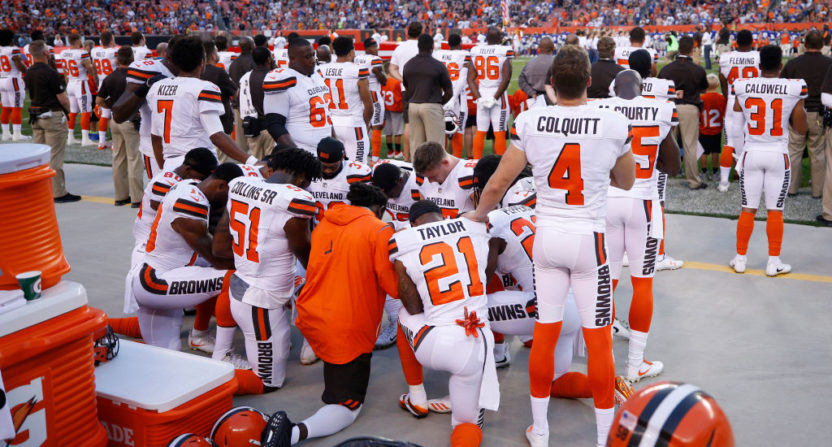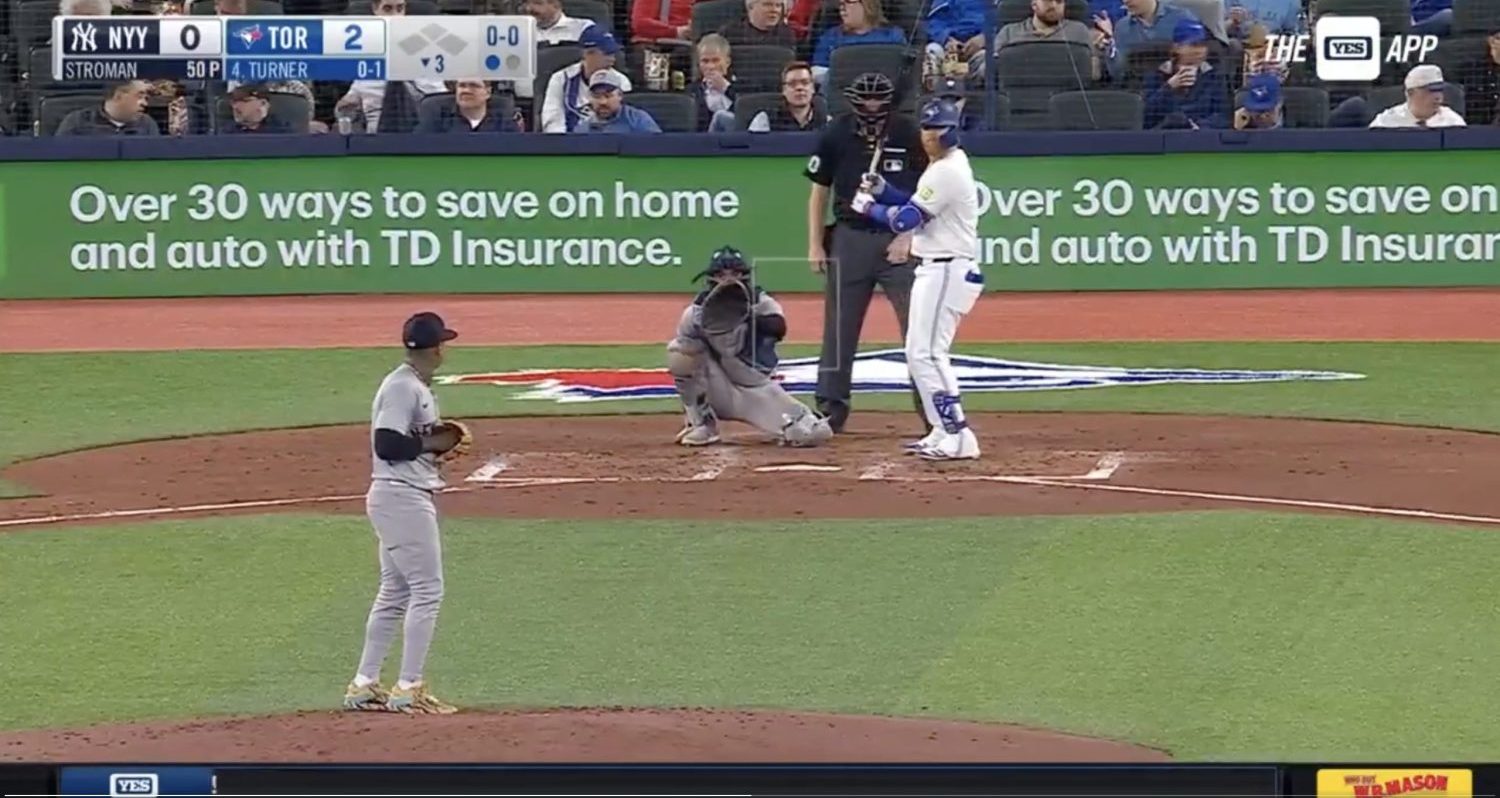With the continued anger about the lack of interest in Colin Kaepernick from NFL teams, as well as the questionable reasoning for why he remains unsigned, there has been a steady stream of condemnation of the NFL from some black fans. Many have said that they will boycott the NFL, whether through not buying tickets, buying team merchandise or watch games, so long as the former San Francisco 49ers quarterback remains on the sidelines.
Why this matters because in a league that is disproportionally black versus nearly every other arena in society, the African-American community provides a significant fraction of the viewership, let alone other forms of support for players and teams. The perceived blackballing of Kaepernick, arguably more than any other controversy in the last few years, has given birth to an inspired response that has gone beyond hashtags. A well-attended rally outside of the league headquarters in New York received significant media coverage, but it was thus far the most public action of a growing movement that appears to be too hard for the NFL to ignore.
Or is it? Broadcasting rights were locked down years ago between the league’s TV partners, with the soonest of the long-term deals to expire in 2021 (ESPN’s Monday Night Football). The NFL already has its dollars unless ratings crater to unheard of depths and the networks talk about renegotiating their deals. (That’s never going to happen.) And even with the loss of over a million male viewers per regular season game last year, the league’s only redress was in relation to the decline was modifying commercial breaks.
This study takes a deep look into the average regular season viewership among black NFL fans since 2013. As with last season’s series where we looked at female viewership, the midway point of the 2016 season, the overstated post-Election Day theory, and the full 2016 regular season, this analysis excludes the NFL Network due to its smaller distribution footprint versus CBS, FOX, NBC, and ESPN. Genders once more are separated to reflect more accurate patterns than the broadness of all viewers – years of surveys and reports tout women making up at least 40% of the NFL’s fan base. However, this study looks beyond the traditional advertising sales breaks for reasons that will become clear as you continue to read on.
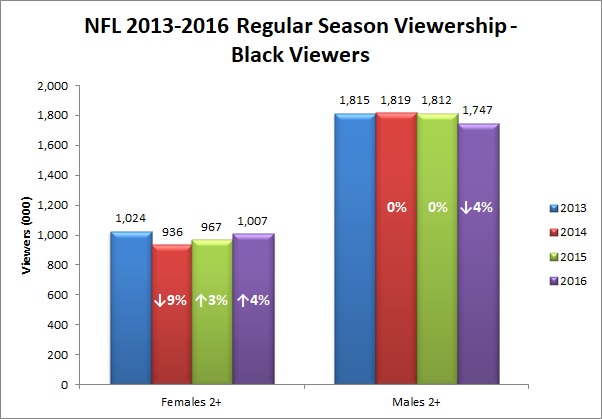
[Source: Nielsen Media Research; 2013-16 NFL regular seasons; Live+Same Day, nationally-televised broadcasts only (CBS, FOX, NBC, ESPN – Excluding NFL Network)]
On a whole since 2013, black viewership was certainly impacted by most of the same factors that had hurt the league with all other viewers – use of illegal streaming for out-of-market games, concerns about brain trauma and CTE, frequent matchups of mediocre-to-bad teams, the retirement of Peyton Manning (and subsequent end to the hype of the friendly rivalry with Tom Brady and his Patriots) and the much-maligned Thursday Night Football window. The fluctuation among all black female viewers is notable for how long it took for the league to regain nearly all of those lost in 2014. The average game was viewed by 1.024 million in the group in 2013, but it dropped by 9% the following year. Two seasons of slight gains puts the average viewership at 1.002 million in the group, about 2% under 2013 (flat in industry parlance).
Among all black males, viewership technically remained flat between 2013 and 2015, hovering around 1.8 million viewers in the group. Yet as was the case will all males in 2016, it wasn’t until last season where there was a discernable decline as the average game took in 4% fewer black male viewers (1.747 million in 2016 vs. 1.812 million in 2015).
Diving deeper into age breaks, however, reveals that even before some black NFL fans began considering a TV boycott, younger demos had already pulled away from the game.
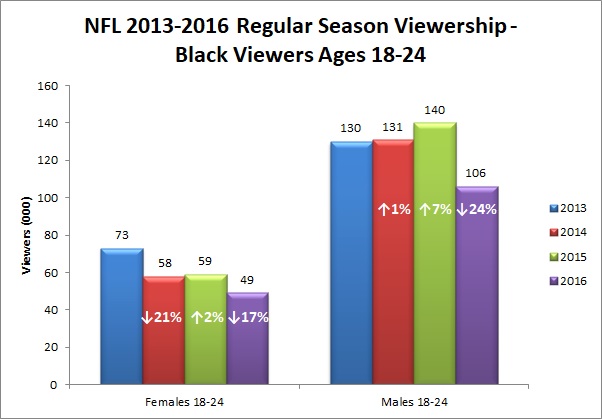
[Source: Nielsen Media Research; 2013-16 NFL regular seasons; Live+Same Day, nationally-televised broadcasts only (CBS, FOX, NBC, ESPN – Excluding NFL Network)]
Whether it’s a mix of watching games through streaming services (legal or not), the popularity of NFL Red Zone or pure disinterest in the game, there were remarkable double-digit declines with both black women (-17%) and men aged 18-24 (-24%) between 2015 and 2016. For young black women, this stood out because they also provided some of the most startling drops between 2013 and 2014 – perhaps as a reaction to the NFL’s handling of the Ray Rice and Greg Hardy domestic violence cases. Over the four seasons, the average game lost 33% of this group (73,000 in 2013 to 49,000 last season). Men of the same age break were notable for a different reason – while this group was unchanged from 2013 to 2014, there was actually a 7% uptick between 2014 and 2015 before the massive drop of 34,000 viewers last season.

[Source: Nielsen Media Research; 2013-16 NFL regular seasons; Live+Same Day, nationally-televised broadcasts only (CBS, FOX, NBC, ESPN – Excluding NFL Network)]
Changes among 18-24 were nearly balanced out by those 25-34, which accounted for 383,000 total viewers in the demo in 2016, which is actually the same total from three seasons prior. Whereas black women in the demo rose above its 2013 levels after its 2014 decline, black men have slipped by 6% over the same four season period. The 4% lift in 2016 was the first increase in the demo after slippage going back to the 2012 season where 259,000 watched an average game.
The same patterns repeated themselves for the next two older age breaks of 35-44 and 45-54: women returned to near or above 2013 totals while men took a step back.

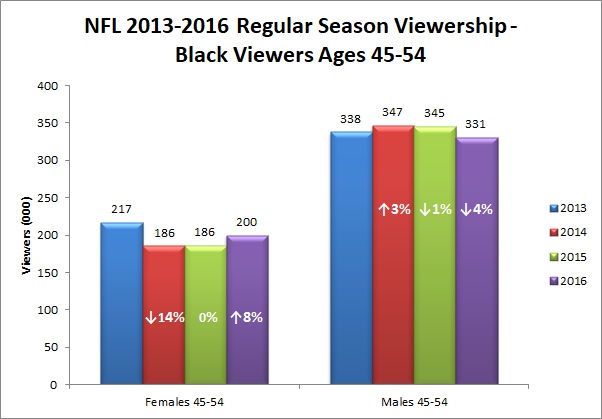
[Source: Nielsen Media Research; 2013-16 NFL regular seasons; Live+Same Day, nationally-televised broadcasts only (CBS, FOX, NBC, ESPN – Excluding NFL Network)]
A most telling piece of these snapshots is that 11% year-to-year loss for black males aged 35-44, losing 33,000 viewers in a season. (Though uncharted, the 262,000 viewers in 2016 represent an even steeper decline from the 315,000 in 2012 – 53,000 fewer black males per broadcast.)
When it comes to ratings, the staying power of the #NFLBlackout lies in some of the older demographics, especially (believe it or not), black adults aged 55 and up – the Baby Boomers and the smaller Silent Generation. Whereas cord-cutting is highly referenced for the younger demos, the older ones are still partial to traditional TV.

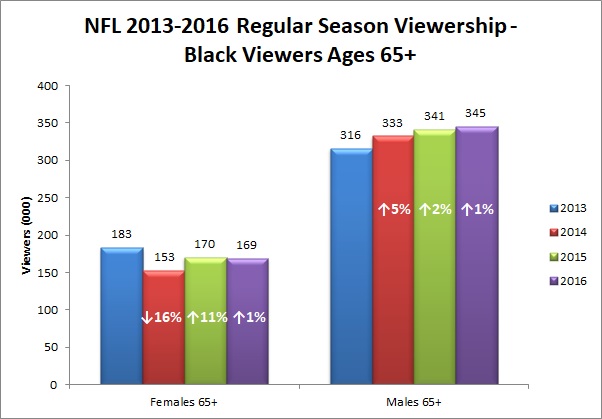
[Source: Nielsen Media Research; 2013-16 NFL regular seasons; Live+Same Day, nationally-televised broadcasts only (CBS, FOX, NBC, ESPN – Excluding NFL Network)]
Over a half million of the NFL’s black viewers were in the 55-64 age break (67% men/33% women), the third-largest measured group after those a decade younger and those above 65 years old. Black women of this demo range not only recovered from the 2014 declines, but they eclipsed 2013’s viewership. Men of the same group only declined between 2014 and 2015 (-6%, approximately 21,000 viewers), but the demo made an 8% jump to have 333,000 total viewers last season.
The latest
Now in fairness, the sustained growth of the older demos is the natural result of just getting older as viewers can only ‘age up’ into a new demo. For that reason, a TV boycott would only be considered viable if there is any noticeable erosion among black Boomers and Silents to couple drops in the already-shifting demos under 55.
There’s no requirement for a team to sign Colin Kaepernick, but the idea that a free agent quarterback with his record has remained unsigned for this long is impossible to comprehend, regardless of how one feels about his method of protesting a season ago. It’s possible that he does get picked up by a NFL team during the regular season, though the possibilities seem pretty remote right now. Yet, the saga has created a groundswell of commentary and decision-making that is akin to the female viewership losses in 2014 in the aftermath of the infamous ‘NFL gone bad’ offseason. Just as reporting on the various transgressions gave some female fans time and information to make decisions about their support, the ongoing blackout discussion has had plenty of time to grow when games were not played. After all, it had been eight months since Kaepernick last threw a pass in a game, and six months since he announced that he would stand for the national anthem going forward.
Committing to not watching games is going to be a challenge for the football addict, but those who go forward understand that TV viewership is the bloodline of the league, more than ticket sales and much more than moving merchandise. There are legitimate concerns about the long-term viability of the #NFLBlackout such as the draw of Super Bowl contenders with leading black stars – see Cam Newton in Carolina in 2015 or Dallas’s resurgence under Dak Prescott last year – the power of fantasy football, and the lack of compelling counterprogramming versus the average game. Regardless, with the likelihood that Colin Kaepernick won’t play a down in the NFL in 2017, it might behoove the NFL to take a look at its ratings among the African-American fan base as its 98th season progresses.

